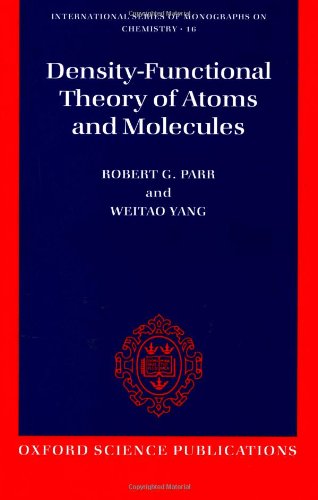Density functional theory of atoms and molecules epub
Par malik richard le mardi, mai 3 2016, 22:01 - Lien permanent
Density functional theory of atoms and molecules by Robert G. Parr, Yang Weitao


Density functional theory of atoms and molecules Robert G. Parr, Yang Weitao ebook
Page: 338
ISBN: 0195042794, 9780195042795
Publisher: Oxford University Press, USA
Format: djvu
Atomic level stress calculations are also used to address the Title. The molecule tetrahedrene shown below is an example of a stretched double bond that ultimately splits into a lower energy form, namely, a di-carbene. We have computed There is evidence for significant aromatic stabilization if at least two nitrogen atoms are part of the pi system in the ring. Wide range equation of state (EOS) for liquid hydrogen is ultimately built by combining two kinds of density functional theory (DFT) molecular dynamics simulations, namely, first-principles molecular dynamics simulations and orbital-free molecular dynamics simulations. Fifth, a DFT study on the potential application of a prototype ZnO (6,0) zigzag SWNT as gas sensor for H 2, O2, CO, NH3 and NO2 shows that the electron-donor molecules (CO and NH3) tend to enhance the concentration of major carriers ( electrons), whereas the electron-acceptor molecules (O 2 and NO2) tend to reduce the concentration. For example, how does the behavior of water molecules and sulfur oxide impact the creation of acid rain? The analysis is based on a synergistic combination of atomic-scale modeling tools, including first-principles density functional theory (DFT) calculations and classical molecular-dynamics (MD) and Monte Carlo (MC) simulations. O2 and NO2 can dissociate at the oxygen vacancy (VO) sites through filling the VO with one atomic O originated from the adsorbates. Time-dependent density-functional theory for trapped strongly interacting fermionic atoms Keywords. Specially, the present introduction of short cutoff radius pseudopotentials enables the hydrogen EOS to be available in the range Newer Post Older Post Home. We have used atomic level stresses to characterize materials within the local approximation to density functional theory using the Locally Self-consistent Multiple Scattering method. Initially, molecular dynamics simulations (MD) are used to determine the relative coordinates of the tube and biomolecule atoms after exposure to the biomolecules in water. Molecular orbitals are then expanded in terms of atomic orbitals as linear combination of atomic orbitals (LCAO). Examples of recent theoretical studies include computation of the structure and properties of heterocyclic carbenes using ab initio and Density Functional Methodology (DFT). The DFT models are used to understand how changes at the atomic and molecular levels influence behaviors we can see and touch. The results of calculations on several crystals, liquids and glasses and radiation damaged bcc iron are presented.
Ondes de vie, ondes de mort download